
The chemistry of isatins a review from 1975 to 1999
.pdf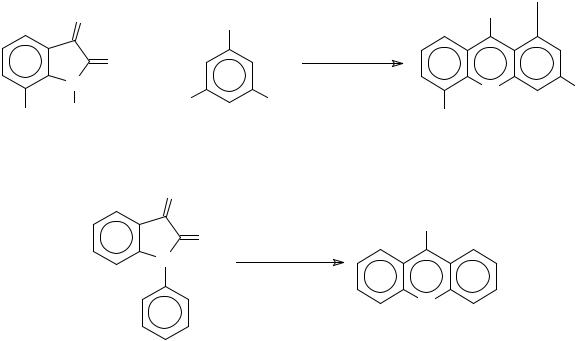
Please use CPS: orgchem/0010004 in any reference to this article
91
O |
|
OH |
|
CO2HOH |
|
|
|
|
|
|
|
O |
+ |
|
|
1) NaOH 2,5N |
|
|
|
2) AcOH (92%) |
|
||
N |
HO |
|
OH |
N |
OH |
F H |
|
||||
|
F |
|
|||
|
|
|
|
O
|
O |
CO2H |
|
N |
1) NaOH 2N |
||
|
|||
|
2) AcOH (96%) |
||
|
|
N
Scheme 122
1-Acylisatin, bearing at least one hydrogen atom at the α position of the acyl group, also furnishes an isatinate, but it reacts with a second equivalent of hydroxide, leading to 3,4- disubstituted -2-quinolones. This heterocyclic system is also formed by treatment of 1- acylisatins with alkoxide solutions497 (Scheme 123).
This article is available from: http://preprint.chemweb.com/orgchem/0010004 Uploaded 17 October 2000 at 14:44 GMT
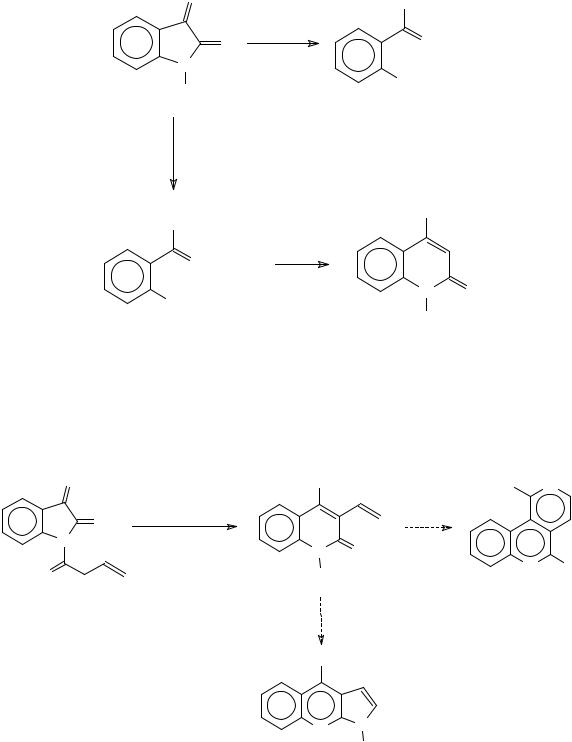
Please use CPS: orgchem/0010004 in any reference to this article
92
O |
|
COOK |
|
|
|
||
O |
KOH aq. |
O |
|
R = H |
|||
N |
|
||
|
NH2 |
||
R |
|
||
COOK |
|
CO2K |
|
|
|
||
O |
|
|
|
NHCOCH3 |
|
N O |
|
KOH aq. R = Ac |
|
|
|
|
|
H |
Scheme 123
The use of N-acylisatins for the construction of quinolones has been applied to the synthesis of pyridoquinolines498 and pyrroloquinolines499 (Scheme 124).
O |
CO2H |
Cl |
N |
|
O |
1) NaOH, H2O |
|
|
|
N |
2) AcOH (80%) |
|
|
|
|
N O |
N |
Cl |
|
O |
H |
|||
|
|
CN
N N
H
Scheme 124
In a similar procedure, 1-iminobenzylideneisatins furnish cinnoline derivatives500
(Scheme 125):
This article is available from: http://preprint.chemweb.com/orgchem/0010004 Uploaded 17 October 2000 at 14:44 GMT
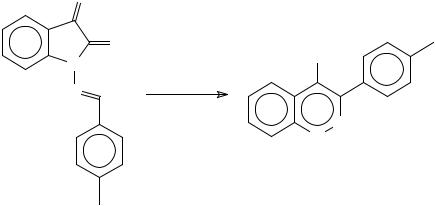
Please use CPS: orgchem/0010004 in any reference to this article
93
O |
|
|
O |
N |
CO2H |
N |
Base |
|
N N |
Scheme 125
3-Dicyanomethyleneoxindoles undergo base catalysed alcoholysis to yield the respective 2-aminoquinolines501. 3-Methyleneoxindoles also suffer ring expansion to quinolones. Mechanistic studies, based on 1H NMR data, show that isomeric methyleneoxindoles lead to the same products through a nucleophilic ring opening step and a subsequent Z-E interconversion step of the benzylidene intermediates. Due to steric repulsions the Z isomer is more stable, but as the cyclization step from the E isomer is irreversible the equilibrium is shifted towards this isomer. The presence of electron-withdrawing groups bonded to the aromatic nucleus shifts the equilibrium in the direction of the Z isomer due to a decrease in the nucleophilicity of the carbamoyl nitrogen atom, and thus favors the cyclization product that results from the Z isomer502 (Scheme 126).
This article is available from: http://preprint.chemweb.com/orgchem/0010004 Uploaded 17 October 2000 at 14:44 GMT
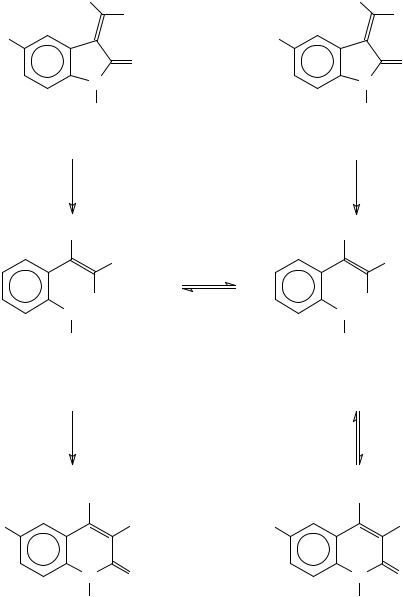
Please use CPS: orgchem/0010004 in any reference to this article
94
MeO2C |
NC |
CN |
CO2Me |
R |
R |
O |
O |
N |
N |
CO2Me |
CO2Me |
E isomer |
Z isomer |
CO2Me |
CO2Me |
CN |
CO2Me |
CO2Me |
CN |
NH |
NH |
CO2Me |
CO2Me |
E benzylidene |
Z benzylidene |
CO2Me |
|
CO2Me |
|
R |
CN |
R |
CO2Me |
N |
O |
|
N NH |
CO2Me |
|
CO2Me |
|
R = H |
81% |
R = H |
0% |
R = NO2 <2% |
R = NO2 |
71% |
|
|
|
Scheme 126 |
|
When the |
alkaline |
hydrolysis is performed with |
N-phenacyl503 or N- |
acetonylisatins504,505, 2-substituted indoles are obtained after spontaneous decarboxylation of the resultant 2-acylindole-3-carboxylic acid . The mechanism of this reaction probably involves a ring opening reaction, followed by cyclization through a Knovenagel-like condensation506, but a very complex mechanism has also been proposed507. This methodology
This article is available from: http://preprint.chemweb.com/orgchem/0010004 Uploaded 17 October 2000 at 14:44 GMT

Please use CPS: orgchem/0010004 in any reference to this article
95
has many advantages over others previously described for the obtention of these indolic derivatives, due to the readily available raw materials (Scheme 127).
O
O
N
O
R
NaOH,
H2O, ∆
O |
ONa |
CO2Na |
|
|
|
||
|
O |
COR |
|
N |
R |
N |
|
|
H |
||
H |
O |
||
|
R = Phenyl or Alkyl
(75-85%)
COR
N
H
Scheme 127
4.3. 4 - Halogen nucleophiles
The reaction of isatin with phosphorous pentachloride led to 3,3-dichlorooxindole when the reaction was carried out in benzene at room temperature. This intermediate has been used in the synthesis of oxindoles substituted at position 3 by reaction with a diverse range of nucleophiles such as KSCN, amines and thiols508. When the reaction was performed with boiling benzene, a red crystalline product was obtained. This compound was originally characterized as 2-chloro-3H-indol-3-one based not on spectral data but on its reactivity. For example, 4-bromoisatin, after reaction with PCl5 in toluene under reflux for eight hours was treated with methanethiol to furnish the corresponding 2,2-thioketal, which was decomposed to 4-bromo-2-methylthio-indolin-3-one509 (Scheme 128).
This article is available from: http://preprint.chemweb.com/orgchem/0010004 Uploaded 17 October 2000 at 14:44 GMT

Please use CPS: orgchem/0010004 in any reference to this article
96
Br |
O |
|
|
Br |
O |
|
|
|
|
||
|
|
O |
1. PCl5 |
|
SMe |
|
|
2. MeSH |
|
N SMe |
|
|
N |
|
|
||
|
|
|
|
||
|
H |
|
|
|
H |
|
|
|
Br |
O |
|
|
|
|
|
|
|
|
|
Φ CH3 |
|
|
|
|
|
∆ |
|
SMe |
|
|
|
|
|
N |
|
Scheme 128
The putative 2-chloro-3H-indol-3-one was also reacted with phenols510 and N,N- dimethylaniline511 to give dyestuffs (Scheme 129).
O |
|
|
|
O |
|
|
|
|
|
|
O |
1. PCl5/∆ |
|
|
|
2. |
R |
R |
|
N |
|
|||
|
|
|
N |
|
H |
|
|
|
|
|
|
|
|
R = OH, NMe2
Scheme 129
On the other hand, the reaction of this chloride with anilines always led to isatin-3- imines. In an attempt to rationalize these contradictory results, it was proposed that 2-chloro- 3H-indol-3-one was the substrate but that this compound, which reacts with nucleophiles at the C-2 position, readily hydrolyzed in solvents containing water, thus yielding isatin and products resulting from attack at C-3512. Sir John Cornforth revisited the chemistry of this compound recently, and elucidated the structure as being 2-(2,2-dichloro-2,3-dihydro-3- oxoindol-1-yl)-3H-indol-3-one based upon 1H, 13C n.m.r. and X-ray crystallographic analysis. The same authors used this compound to synthesize an indoloquinazoline structurally related to the alkaloid tryptanthrin513 (Scheme 130).
This article is available from: http://preprint.chemweb.com/orgchem/0010004 Uploaded 17 October 2000 at 14:44 GMT
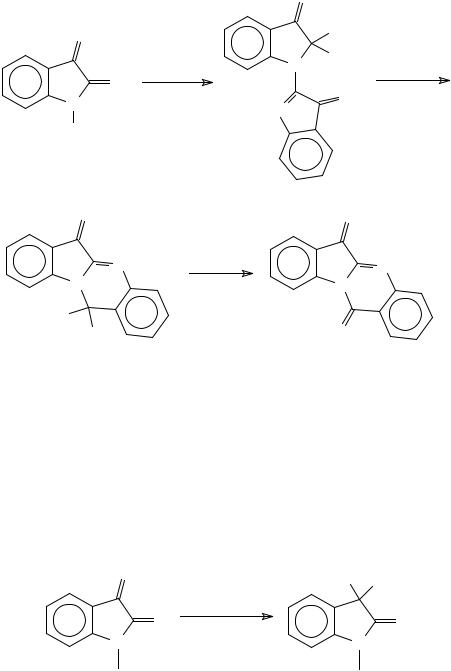
Please use CPS: orgchem/0010004 in any reference to this article
97
|
|
|
O |
|
O |
|
|
|
Cl |
|
|
PCl5 |
N |
Cl |
|
O |
MeOH |
||
|
|
|||
|
Φ H/∆ |
|
O |
|
N |
|
N |
||
|
|
|
||
H |
|
|
|
|
|
|
|
|
O |
|
O |
N |
light |
N |
N |
|
N |
(MeO)3C |
|
O |
OH |
|
Scheme 130
1-Methylisatin reacts with diethylaminosulfur trifluoride (DAST) to furnish 1-methyl-
3,3-difluorooxindol in 95% yield514. This methodology has been subsequently modified and
extended to the synthesis of numerous other 3,3-difluorooxindole derivatives130,515 (Scheme
131).
O |
F F |
O |
DAST |
O |
|
N |
N |
Scheme 131
5 - Metal complexes
Isatin, due to its cis α -dicarbonyl moiety, is a potentially good substrate for the synthesis of metal complexes, either alone or with other ligands. Their derivatives, mostly those substituted at C-3, such as isatin-3-hydrazones and isatin-3-imines bearing an extra heteroaromatic ring are also generally employed as ligands. In this manner, Schiff bases
This article is available from: http://preprint.chemweb.com/orgchem/0010004 Uploaded 17 October 2000 at 14:44 GMT
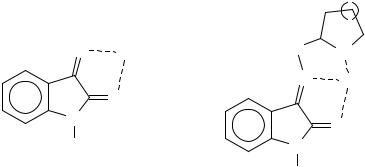
Please use CPS: orgchem/0010004 in any reference to this article
98
formed from isatin and amino silica gel are useful sorbents for divalent cations and for Fe (III)516 (Scheme 132).
|
|
n |
|
O MLn |
X |
Y |
|
O |
N |
MLn |
|
|
|
||
N |
|
O |
|
H |
N |
||
|
|||
|
H |
|
Scheme 131
Due to its ability to bind ferric ions, isatin-3-thiosemicarbazone can be used to form magneto-polymer composites with poly (vinyl chloride)517.
An extensive list of metal complexes can be found in the Supplementary Material 3.
6. Crystallographic and spectral analysis
6.1 - Crystallographic data
The crystallographic data for isatin reveals that it is almost planar, with a bond length between the two carbonyls of 1.55 Å. This large value was attributed to lone pair electron repulsion between the two oxygen atoms518,519, though this interpretation was subsequently refuted by comparison of bond lengths of cis and trans 1,2-diketones where no systematic or substantial difference between the bond lengths was observed520. A similar bond length was
observed for |
1-acetylisatin521, 1-α -chloroacetylisatin522, diethyl (2,3-dihydro-2-oxo-3- |
indolylidene)propanedioate523, 1,1’-oxalylbisisatin524 and 1-methylisatin525, as well as in derivatives where C-3 is tetrahedral, such as 3,3-dichloro-1H-indol-2(3H)-one526 and 5’- bromospiro-[1,3-dioxolano-2,3-indolin]-2’-one527, as well as in 3-methyleneoxindoles528
(Table 1) and in products obtained by nucleophilic ring opening of 1-acetylisatin, where the 1,2-dicarbonyl system assumes a s-trans conformation529. The crystal structure of 2- methoxyisonitrosoacetanilide, an intermediate in the Sandmeyer procedure for the synthesis of 7-methoxyisatin has also been determined530.
This article is available from: http://preprint.chemweb.com/orgchem/0010004 Uploaded 17 October 2000 at 14:44 GMT

Please use CPS: orgchem/0010004 in any reference to this article
99
Table 1
|
R2 |
X |
|
|
O |
|
|
|
|
|
|
|
|
N |
|
|
|
R1 |
|
X |
R1 |
R2 |
C2-C3 |
O |
H |
H |
1.55 |
O |
Ac |
H |
1.538 |
O |
Me |
H |
1.545 |
Cl, Cl |
H |
H |
1.556 |
OCH2CH2O |
H |
Br |
1.539 |
CHCH=C(CH3)2 |
H |
H |
1.508 |
6.2 - Infrared spectroscopy
The infrared spectrum of isatin shows two strong bands at 1740 and 1620 cm-1 corresponding to the carbonyl stretching vibrations. A broad band occurs at 3190 cm-1 due to the N-H stretching, and it is accompanied by many sub-bands, all of which are moved to a lower frequency on deuteration, which also affects several bands in the region of 1400-1100
cm-1, associated with N-H in-plane bending531,532. Although the ν C=O values are not modified
by N-alkylation, N-acetylation leads to a hypsochromic shift of the lactam absorption of about 50-70 cm-1, while the ketone band shifts to 1750 cm-1, as a consequence of the extension of conjugation of the nitrogen lone pair with the acetyl group100. On the other hand, 3- methyleneoxindoles show a bathochromic shift for the lactam band of around 20 to 30 cm-1, this shift being greater when there are groups at the C-3 position, such as OH, which can form
a hydrogen bond with the lactam carbonyl. In this case, ν C=O appears at 1660 cm-1 438. 3,3-
Difluorooxindoles reveal a hypsochromic shift of about 20 cm-1 in comparison to the
respective isatin514.
This article is available from: http://preprint.chemweb.com/orgchem/0010004 Uploaded 17 October 2000 at 14:44 GMT

Please use CPS: orgchem/0010004 in any reference to this article
100
6.3 - 1H NMR spectroscopy
The 1H NMR spectrum of isatin shows the signals of the aromatic nucleus signals at 6.86 (doublet), 7.00 (triplet), 7.47 (doublet) and 7.53 (triplet) ppm (DMSO-d6), corresponding to H-7, H-5, H-4 and H-6 respectively. While N-alkylation does not alter this pattern, N- acetylation leads to a downfield shift of all the signals, but most significantly of H-7 due to the anisotropic effect of the carbonyl group. In a similar fashion, 3-methyleneoxindoles bearing cyano groups reveal a downfield shift of H-4 by about 0.6-1.0 ppm, with no significant effect over the other signals533,534 (Table 2).
Table 2533
X
|
|
|
|
N |
O |
|
|
|
|
|
|
|
|
|
|
|
|
|
|
R |
|
|
|
|
|
|
|
|
|
|
|
X |
R |
H-4 |
H-5 |
H-6 |
H-7 |
CH3CO |
Solvent |
O |
H |
7.50d |
7.07t |
7.60t |
6.92d |
- |
DMSO-d6 |
O |
Me |
7.59d |
7.12t |
7.61t |
6.91t |
- |
DMSO-d6 |
O |
Ac |
7.27d |
7.33t |
7.70t |
8.38d |
2.73s |
DMSO-d6 |
C(CN)2 |
H |
7.87d |
7.12t |
7.59t |
6.94d |
- |
DMSO-d6 |
6.4 - 13C NMR spectroscopy
The 13C NMR spectrum of isatin was the object of controversy in the literature. Different proposals for assignment of the signals have been published42,535,536,537. This question was resolved by the obtention of the HETCOR spectrum, which revealed that the assignment proposed by Galasso, based on quantum mechanical calculations using the
This article is available from: http://preprint.chemweb.com/orgchem/0010004 Uploaded 17 October 2000 at 14:44 GMT
